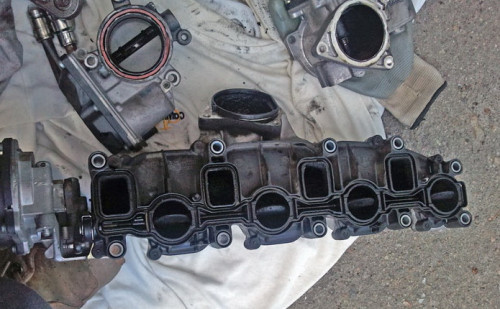
The process for removing the flaps depends on the design, in some cases the manifold is unbolted and the flaps physically removed, in other cases where the mechanical status of the flaps are good and the fault is due to an electronic actuator, the actuator function can be disabled and the flaps left in place.
The reduction in emissions and performance at low engine speeds is almost unnoticeable and would only be relevant if no carbon build up had occurred, due to the fact that carbon build up begins as soon as the vehicle leaves the factory, the removal of the flaps is likely to result in increased performance and efficiency.
The reduction in emissions and performance at low engine speeds is almost unnoticeable and would only be relevant if no carbon build up had occurred, due to the fact that carbon build up begins as soon as the vehicle leaves the factory, the removal of the flaps is likely to result in increased performance and efficiency.
A swirl flap is a small butterfly valve fitted to four-stroke internal combustion engines with at least two intake valves. It is installed inside or just before one of a cylinder's two intake ports, allowing to throttle its intake port's air flow, causing a swirl in the other intake port not fitted with a swirl flap. The swirl improves the air-fuel mixing process in direct injected engines, typically diesel engines, under low load conditions.
Swirl flap position is adjusted by an electrical or vacuum-actuated servo mechanism which is under the control of the engine management system. In a typical implementation the flaps will be closed at idle speed, creating additional turbulence in the intake. As engine speed increases, the flaps are gradually opened until, at around 2,000/min, they are parallel to the airflow and present virtually no resistance. Their purpose is to ensure that the air entering the cylinder is sufficiently turbulent for good fuel-air mixing even at low engine speeds. This aids in reducing emissions and may also improve low-end torque.
Swirl flap position is adjusted by an electrical or vacuum-actuated servo mechanism which is under the control of the engine management system. In a typical implementation the flaps will be closed at idle speed, creating additional turbulence in the intake. As engine speed increases, the flaps are gradually opened until, at around 2,000/min, they are parallel to the airflow and present virtually no resistance. Their purpose is to ensure that the air entering the cylinder is sufficiently turbulent for good fuel-air mixing even at low engine speeds. This aids in reducing emissions and may also improve low-end torque.
Are mainly associated with fouling by exhaust gas recirculation, which leaves tarry deposits on the flaps and the inside of the intake manifold. Over time the flaps can begin to stick in one position and the engine management system may report an error code if the correct flap position cannot be achieved within a few percent of the design specification.
Loss in boost pressure will cause a vehicle to run rich and can damage other components such as DPF, EGR, etc..
Loss in boost pressure will cause a vehicle to run rich and can damage other components such as DPF, EGR, etc..
AFR Tuning
Check the power of your car!

Car brand
Choose a brand


Car Model
Choose a model


Car Modification
Choose a modification

Original
hp
Nm
After Tuning
hp
Nm
Increase
hp
Nm
Contacts
Send us a message
Contacts:
Riga/ Daugavpils/ Liepaja/ Nereta/ London Riga, Latvia-1050
E-mail:
info@cafr.lv
Phone:
+371 27 444 330
